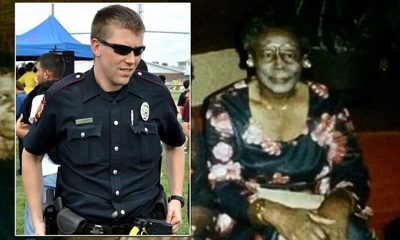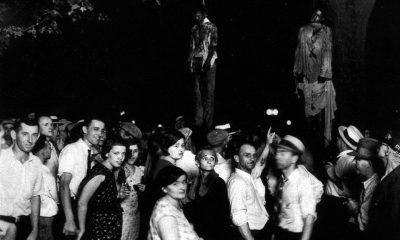Utah
Health Crisis for Black Children
Recent research indicates that while racism may not be the prevailing form of discrimination, it exerts the most significant influence on adolescents.
The lawsuit filed against a Georgia school district earlier this year highlights various allegations, including the dismissal of student complaints regarding the use of racist slurs, the punitive treatment of Black children who reported instances of discrimination, and the disturbing reenactment of the killing of George Floyd by Minneapolis police officers by white students.
The aforementioned scenario merely represents a fraction of the extensive stress that Black adolescents encounter during their developmental years. Racism, along with its associated chronic stress, has been found to have a detrimental impact on the health of Black Americans, contributing to the emergence of health inequalities across many conditions such as anxiety, heart disease, and cancer. Moreover, this phenomenon is observed to commence at an exceptionally early stage of development.
The stress experienced by Black children frequently arises from instances of racism within educational environments, which may manifest in interactions with classmates, educators, or school administrators. The current situation can be characterized as a simultaneous manifestation of mental and physical health challenges. Notably, the impact of stress on the bodies of Black boys and girls may exhibit gender-specific variations.
Recent research conducted at the University of Michigan has revealed that while racism may not be the prevailing form of prejudice, it exerts the most significant influence on a cohort of 100 adolescents aged 13 to 19 who participated in the study. In order to assess the extent of influence, the researchers examined instances of heightened levels of cortisol, a stress hormone. The presence of cortisol in the body, in isolation, does not inherently cause harm. Throughout the course of a typical day, the levels of [the variable in question] exhibit fluctuations that vary from morning to evening. The human body is inherently equipped to manage and cope with such circumstances. However, the deleterious impact on individuals’ health occurs when the regular patterns are broken or when it persists at heightened levels over prolonged durations, specifically due to discriminatory practices. Consequently, this erosion of health manifests in a cascade of health-related complications.
Black boys and girls are currently contending with many challenges.
In the state of Utah, there exists a situation where two adolescent sisters of African descent are facing challenges within an educational setting that is largely populated by individuals of Caucasian ethnicity.
One individual recounted an incident when children would occupy the rear section of the bus, directing their attention towards the speaker and engaging in discussions pertaining to racial slurs, specifically the N-word, while expressing their perception that being both Black and female must be an unfavorable experience.
According to one individual, a group of youngsters inquired about my preference for bananas and my proficiency in tree climbing. She was informed that her appearance had resemblance to that of a primate.
According to an article by The Salt Lake Tribune, those affected by racist acts may experience physical manifestations such as anxiety or involuntary bodily movements. The individuals in question are not in a state of solitude. There has been a significant accumulation of reports documenting incidents of racism within educational institutions around the nation. According to studies, the worry exhibited by the sisters is indicative of a more widespread sense of disquiet that is commonly observed among Black females.
What are the concerns or anxieties that occupy their thoughts?
The individuals exhibit apprehension regarding the perceptions of individuals from different racial backgrounds, their social integration inside the educational institution, and their prospects for the future. The individuals express their apprehension towards instances of police brutality and the perpetuation of stereotypes. The presence of inequity and gender-based discrimination.
According to a poll conducted in Ohio, with a sample of over 400 Black females aged 11 to 18, it was found that a majority over 60% see instances of racial mistreatment, while a comparable amount feel subjected to gender-based unjust treatment.
The research was led by Fran Frazier.
Subsequently, her research involving young Black girls has revealed several stresses that impact their emotional and physical well-being, encompassing issues such as bullying, colorism, body-shaming, and challenges related to navigating LGBTQ identities. According to Frazier, the founder of Black Girl Rising, a significant number of girls within our community frequently find themselves in situations characterized by a constant state of fight, flight, or emotional detachment. Cortisol has a significant role in the aforementioned phenomenon.
According to Steven Kniffley Jr., the senior assistant dean for Diversity, Equity, and Inclusion (DEI) at the University of Cincinnati’s College of Medicine, children of African descent typically encounter their initial encounter with microaggressions by the age of six. According to Kniffley, an expert in the field of race-based trauma, individuals are likely to encounter microaggressions on a frequent basis during their developmental years. These microaggressions can manifest in various forms, such as being excluded from social groups or being subjected to ridicule based on physical attributes, such skin color or hair texture. The suspension of an 18-year-old individual in Texas garnered significant attention around the nation due to the violation of the school district’s dress code by wearing locs.
The individual expressed that this trajectory ultimately results in self-loathing and self-destructive behavior. Kniffley expresses concern on the incidence of suicide within the Black community. Black males frequently experience stress related to their masculinity, since they are regularly exposed to societal messages that encourage them to diminish their presence in order to evade discrimination. This may manifest in behaviors such as slouching, speaking softly to accommodate others, and managing their interactions with law enforcement personnel.
What strategies can be employed to interrupt the ongoing cycle?
In order to address the situation at hand, professionals are urging elected representatives and administrators within school districts to implement comprehensive and structured reforms. However, in the interim, it is recommended that parents, educators, and members of the community provide support to young individuals by actively participating in meaningful dialogues regarding their experiences. Additionally, they should encourage the development of robust social connections and promote the utilization of physical exercise as a means to effectively cope with stress.
Frazier, located in the state of Ohio, expresses the desire for adults to initiate a transformation in the manner in which they communicate with younger individuals. According to her, the question “How did school go today?” frequently elicits brief responses. There has been a modification in the nature of the inquiries she poses.
What knowledge or skills did you acquire today that will be beneficial to you?
Is there a matter of concern that is troubling you?
I have observed that you are frequently attired in black or brown garments. Might this indicate a growing preference for these particular hues? What aspects of the hue do you find appealing?
Exercise is commonly recommended by experts as a means to alleviate bodily tension, while the cultivation of social support networks is advocated as a strategy to mitigate the impact of stress.
According to the findings of the Michigan study, it was seen that Black adolescents reported a higher frequency of encountering instances of discrimination compared to their white counterparts. Additionally, the study revealed that these incidents of discrimination were associated with increased levels of stress among Black teenagers. The experience of discrimination originating from one’s friends was found to elicit a higher level of stress compared to receiving comparable comments from those who are not acquainted, or even in comparison to the stress resulting from unfair treatment by teachers or administrators.
According to Hasson, a professor at the University of Michigan, it is logical to assert that social ties hold significant importance in the lives of adolescents. The author observed that social media has the potential to magnify prevailing patterns. According to her, it provides adolescents with round-the-clock availability to their classmates.
However, according to Hasson, merely acknowledging the pervasiveness of racism is insufficient. According to the speaker, although there are immediate coping measures available to families, it is crucial to prioritize the eradication of toxic stress. According to Hasson, similar to the undesirable presence of a child in a residence contaminated with toxic lead, it is also undesirable for children to be exposed to stressful circumstances in the company of their peers.
New research shows that although racism might not be the most common type of discrimination, it had the greatest impact on teens
Ignored complaints of students using racist slurs, Black children getting in trouble for reporting instances of discrimination, and white students mockingly reenacting the killing of George Floyd by Minneapolis police officers are all outlined in a lawsuit that hit a Georgia school district earlier this year.
The case is just the tip of the iceberg when it comes to the repeated stress Black youth are exposed to as they’re growing up. Racism, and the chronic stress that it causes, is weathering Black Americans’ health, driving health disparities from anxiety to heart disease and cancer. And, it’s starting at an incredibly young age.
For Black kids, that stress is often caused by racism that comes in school settings: from peers, teachers, or administrators. It’s bleeding into both a mental and physical health crisis, and for Black boys and girls, exactly how that stress looks and affects their bodies can vary by gender.
New research from the University of Michigan shows that although racism might not be the most common type of discrimination, it had the greatest impact on the 100 adolescents ages 13 to 19 that were surveyed. To measure impact, the researchers looked at spikes in a stress hormone, called cortisol. In and of itself, cortisol’s presence in the body isn’t harmful. On any given day, its levels fluctuate from morning to evening. The body’s designed to handle it. But it’s when the normal patterns are disrupted or it remains elevated for extended periods of time — in this case, as a result of discrimination — it erodes people’s health, spiraling into health issues.
What Black boys and girls are battling
In Utah, two Black teen sisters are struggling in a predominantly white school district.
“These kids would sit in the back of the bus, looking at me and talking about the N-word and how it must really suck to be Black and a woman,” one shared.
Some students “began asking me if I liked bananas, if I was good at climbing trees,” the other said. They told her she looked like a monkey.
The stress from the racist incidents sometimes shows up in their bodies as anxiety or uncontrollable body twitches, The Salt Lake Tribune reported. They are not alone. Reports of racism in schools have piled up across the country. And the anxiety the sisters carry reflects a broader unease experienced by many Black girls, research shows.
What do they worry about?
They’re concerned about what people of other races think about them, acceptance at school, and their futures. They say they’re afraid of police brutality and stereotypes. Unfairness and sexism.
Of the more than 400 Black girls ages 11 to 18 surveyed in Ohio, over 60% believe they’ve been mistreated because of their race and a similar percentage feel they’ve been treated unfairly because of their gender.
Fran Frazier led that research.
Since then, her work with other young Black girls has identified a handful of different stressors affecting their mental and physical health, from bullying and colorism to body-shaming and difficulty navigating LGBTQ identity. “Many of our girls are always in a fight, flight, or numbing situation,” said Frazier, founder of Black Girl Rising. “Cortisol has a lot to do with that.”
Black kids, on average, experience their first microaggression by age 6, said Steven Kniffley Jr., the senior associate dean for DEI at the University of Cincinnati’s College of Medicine. Kniffley, who studies race-based trauma, says they’ll be exposed to microaggression multiple times a day as they grow up, which can look like exclusion from groups or being made fun of for their physical appearance like skin color or hair texture. An 18-year-old in Texas made national headlines after being suspended because his locs violated the school district’s dress code.
“It’s all leading to us hating ourselves and killing ourselves as part of the process,” he said. Kniffley worries about Black suicide rates. For Black boys, the stress is often around masculinity and messages that teach them to shrink themselves in order to avoid discrimination, like hunching over, talking softly to make others more comfortable, and navigating interactions with police officers.
“How do we disrupt the cycle?”
To fix the crisis, experts are calling on elected officials and school district administrators to create systematic change. But in the meantime, they suggest parents, educators, and community members can support the youth by engaging them in meaningful conversations around what they’re going through, encouraging them to build strong social networks and use exercise as a way to manage stress.
Frazier, in Ohio, hopes adults start to shift the language they use with young folks. “How did school go today?” often prompts one word answers, she said. She has shifted the types of questions she asks:
What did you learn today that is going to help you?
Is there something worrying you?
I noticed that you’re wearing a lot of black or brown, is this becoming your favorite color? What do you like about that color?
Experts also recommend exercise as a way to release tension in the body, and cultivating support social support networks to buffer against the stress.
In the Michigan study, Black adolescents reported experiencing discrimination more frequently than white teens, and noted feeling more stress as a result of a given incident. Discrimination from peers was more stressful than similar comments from strangers or the stress or unfair treatment from teachers or administrators.
That makes sense, said Hasson, the University of Michigan professor, given that social relationships are among the most important in teenagers’ lives. She noted that social media may amplify the trends. It gives teens 24-hour access to their peers, she said.
Still, “it’s not enough to accept that racism is pervasive,” said Hasson. While there are coping strategies families can use right away, our focus should be on eliminating that toxic stress, she said. Just like we don’t want a child in a house full of poisonous lead, said Hasson, we don’t want kids in stressful environments among their peers.

-

 States2 weeks ago
States2 weeks agoPearlie Golden 93-Year-Old Black Woman Shot By Texas Cop
-

 States2 weeks ago
States2 weeks agoLayers Of Racial Tension The Mario Woods Tragedy And San Francisco Path To Justice
-

 States2 weeks ago
States2 weeks agoTragedy Unveils Racial Tensions Tarika Wilson Story
-

 States2 weeks ago
States2 weeks agoLynching Of Thomas Shipp Tragedy Of Racism Echoes Through History
-

 States2 weeks ago
States2 weeks agoThe Killing Of Terence Crutcher And The Fight For Racial Justice

















You must be logged in to post a comment Login